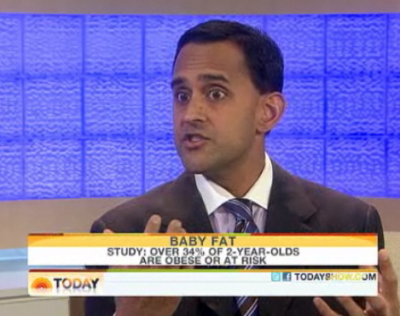|
|
Darshak M. Sanghavi, MD, assistant professor of pediatrics, appeared on NBC’s “Today Show” this morning to talk about childhood obesity. Dr. Sanghavi, the author of A Map of the Child: A Pediatrician’s Tour of the Body, spoke with host Matt Lauer about a recent study indicating that one-third of U.S. infants are obese or at risk for obesity, a finding of significant concern among parents, pediatricians and public health officials across the country.
The collaborative study, conducted by researchers at Wayne State University’s School of Social Work in Detroit and the Institute for Social Research at the University of Michigan at Ann Arbor, was published in the January/February 2011 issue of the American Journal of Health Promotion.
The study followed 8,000 infants born in 2001 and noted that those found to be obese—those whose weight-to-height ratio was above the 95th percentile on standard growth charts—at 9 months old were at higher risk for being obese at 2 years old. The authors note that numerous other studies have found that obesity in early childhood could lead not only to obesity in later childhood but also to related health issues, such as heart disease, diabetes, asthma, high blood pressure and cancer. Childhood obesity has more than tripled in the past 30 years, according to the Centers for Disease Control.
“For some time, researchers thought that obesity was a problem of late childhood,” said Sanghavi. “But this new study shows that, increasingly, many infants are too large by 9 months. Interestingly, this trend affects almost all races, areas of the country and all income levels—which also challenges assumptions that obesity was only a problem of poor urban kids.”
Sanghavi pointed out that, although the study doesn’t explain why babies are larger, two of the most likely theories today suggest that infant feeding practices may be excessive—parents may too quickly offer formula and food to soothe a crying baby, for example, when the child is simply fussy and not actually hungry—and pregnant women are more likely to be overweight. Studies strongly show that overweight women are more likely to have large babies.
The Wayne State study also found that:
- 34.3 percent of 2-year olds were obese or at risk for obesity;
- 17 percent of the infants were obese at 9 months, rising to 20 percent at 2 years;
- 44 percent of the infants who were obese at 9 months remained obese at 2 years;
- Hispanic and low income children were at greater risk for weight gain;
- Females and Asian/Pacific Islanders were at lower risk for undesirable weight changes;
- 40 percent of 2-year olds from the lowest income homes were at risk or obese compared to 27 percent of those from the highest income homes.
Sanghavi noted that the study also shows that roughly half of the babies who were obese at 9 months were not obese at 2 years, suggesting that parents may be able to make a difference in their children’s health and help their babies to develop into a normal weight.
Sanghavi, who is chief of pediatric cardiology for UMass Memorial Children’s Medical Center, regularly writes features for National Public Radio’s “All Things Considered,” The New York Times Magazine, The Boston Globe Magazine and Slate, and has appeared on CNN and the “Today Show” several times.
To watch the “Today Show” interview, click on: http://moms.today.com/_question/2011/01/03/5757277-do-you-worry-about-your-baby-being-too-fat\
